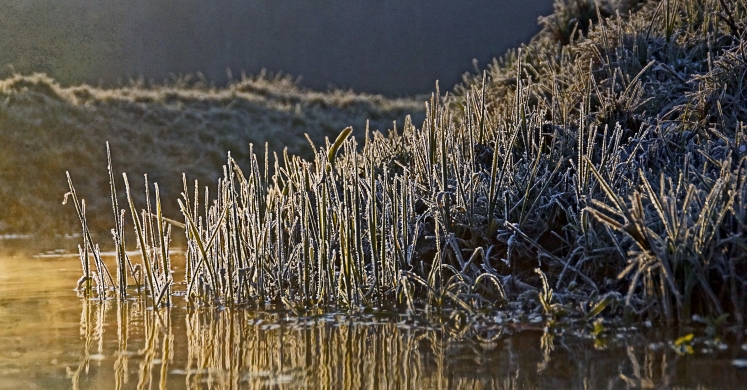Blog

#bioPGH Blog: Frosty Mornings
 A resource of Biophilia: Pittsburgh, #bioPGH is a weekly blog and social media series that aims to encourage both children and adults to reconnect with nature and enjoy what each of our distinctive seasons has to offer.
A resource of Biophilia: Pittsburgh, #bioPGH is a weekly blog and social media series that aims to encourage both children and adults to reconnect with nature and enjoy what each of our distinctive seasons has to offer.
Jack Frost, Frau Holle (Mother Hulda), Old Man Winter, the Frost King…oral traditions from around the world have a number of potential perpetrators responsible for the delicate beauty of a frosty morning. From the intricate, feathery patterns on a window to the dusting of crystals on leaves and fences, frost is autumn’s way of teasing us with winter, and it’s a delightful excuse to enjoy that steaming cup of pumpkin spice coffee on a brisk morning. Have you ever wondered how frost forms, though? Grab a fuzzy scarf, and let’s explore!
In one way, frost can be thought of as the cold-weather counterpart to dew. Just as there is a dew point, there is also a frost point. If we dig back through our earth science memory, we can recall that the dew point temperature is the point when the water vapor in the air has reached saturation and begins to condense, resulting in dew formation. When the dew point temperature is below freezing, it is considered the frost point. Similar to snowflake crystals, which build on particles in the atmosphere, frost crystals grow as water vapor encounters solid structures such grass or the last of season’s flowers. You may even notice frost on the ground when it appears that the temperate did not drop below freezing, but remember: warm air rises and cool air falls. The air temperature at the ground level may be a few degrees cooler than what we would identify as the air temperature overnight, thus allowing frost to form.
In a slightly different freezing fashion, window frost occurs from the heat on in the inside of window clashing with the cold air outside the window. The water vapor from the outside condenses on the window from the indoors’ warmth, and that condensed vapor freezes to the surface of the window. This is less common with double-paned windows that are meant to prevent the escape of heat in the winter or A.C. in the summer. Car windows and older homes, though, often have beautiful works of frosty art during the colder months!
If you just can’t wait for the next cold morning to see some crystalline fuzz, try this home experiment to make frost: Take two empty soup or vegetable cans without the labels and fill them both with crushed ice (you can just crunch up some full size cubes in a ziplock baggie if you only have cubes). Pour cool water into one can to fill the empty space, but for the other can, mix a cup of cool water with roughly five tablespoons of table salt before adding the mixture to the crushed ice. Then allow the cans to sit for a while. Do you notice any difference between them? If you keep a nature journal, be sure to write down what you observed!
Remember, to be considered an “experiment” as opposed to just an activity, the activity needs to be inquiry-based. If you’re making frost as a family, ask your children to make a hypothesis (best guess) about which can will form frost on the outside. Ask them why they added the salt to one of the cans. What does salt do? It lowers the freezing point of the water mixture in the can, which allows the frost to form on the outside of the salty can but not the unsalted can.
Connecting to the Outdoors Tip: The next time you see a frosty morning when the weather seems just a bit too warm, take an outdoor thermometer and measure the temperature at the ground level. Then measure the air temperature at eye level or perhaps on a second floor balcony. Is there any difference?
Continue the Conversation: Share your nature discoveries with our community by posting to Twitter and Instagram with hashtag #bioPGH, and R.S.V.P. to attend our next Biophilia: Pittsburgh meeting.
Resources

